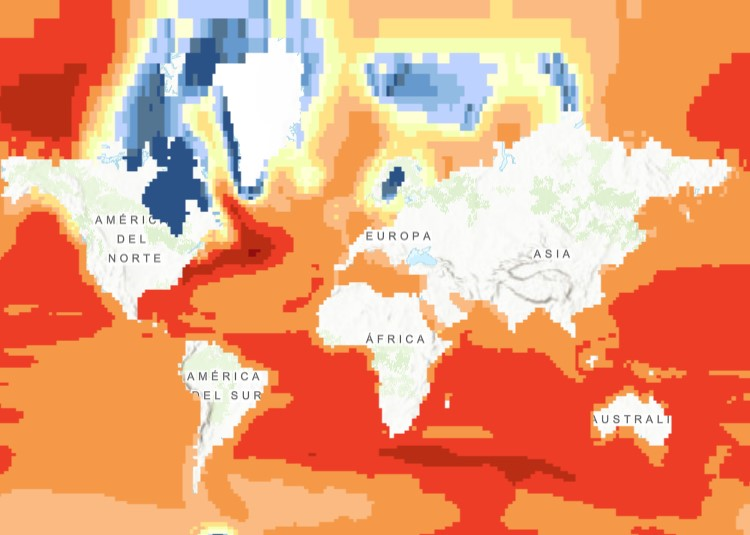climatologyMeteorologyAtmosphere
Type of resources
Available actions
Topics
INSPIRE themes
Keywords
Contact for the resource
Provided by
Years
Formats
Representation types
Update frequencies
status
Scale
Resolution
-
Rå meteorologiske punktmålinger som f.eks. temperatur, nedbør og vind fra DMI's målestationer I Danmark og Grønland. Data kan tilgås i realtid og historisk tilbage til 1953
-
Kvalitetssikrede meteorologiske punktmålinger fra DMI's målestationer i Danmark og Grønland.
-
Havvand på Land er et afledt hydrologisk analyseprodukt som er beregnet på baggrund af højdemodellen Havstigning. Havvand på Land viser hvilke arealer der bliver oversvømmet ved en given havvandstand. Hver celleværdi angiver det havniveau over middelvandstand, der foranlediger oversvømmelse af cellen.
-
Flow ekstremregn er et rasterkort der viser oplandsstørrelse i kvadratmeter for hver celle. Kortet kan bruges til at analysere hvor vandet ville løbe i tilfælde af ekstremregn. Det antages at terrænet er uigennemtrængeligt, dvs. det vil vise en worst-case-scenarie hvor der ikke tages højde for kloakafløb og nedsivning. Produktet kan anvendes selvstændigt eller f.eks. kombineres med Bluespot for at undersøge, hvor vandet i en given bluespot kommer fra.
-
Soil moisture deficit during the vegetation growing season, annual time-series, 2000-2019, Sep. 2020

The dataset consists of a collection of annual soil moisture (SM) anomalies during the vegetation growing season (GS) for the years 2000-2019 across EEA 38 area and the United Kingdom. The vegetation growing season is defined by EEA´s phenology data series "Vegetation growing season length 2000-2016", available in the EEA website and in this catalogue. The anomalies are calculated based on the European Commission's Joint Research Centre European Drought Observatory (EDO) Soil Moisture Index (SMI) with respect to the 1995–2019 base period. The yearly start and end of GS periods are dynamic and calculated according to the EEA Phenology Indicators. A positive anomaly indicates that the observed SM was wetter than the long-term SM average for the base period, while a negative anomaly indicates that the observed SM was drier than the reference value. Because SM anomalies are measured in units of standard deviation from the long-term SMI average, they can be used to compare annual deficits/surplus of SM between geographic regions. EDO is one of the early warning and monitoring systems of the Copernicus Emergency Management Service. As the dataset builds on EDO's SMI, it therefore contains modified Copernicus Emergency Management Service information (2019).
-

The raster dataset of urban heat island modelling shows the fine-scale (100m pixel size) temperature differences (in degrees Celsius °C) across 100 European cities, depending on the land use, soil sealing, anthropogenic heat flux, vegetation index and climatic variables such as wind speed and incoming solar radiation. In the framework of the Copernicus European Health contract for the Copernicus Climate Change Service (C3S), VITO provided 100m resolution hourly temperature data (2008-2017) for 100 European cities, based on simulations with the urban climate model UrbClim (De Ridder et al., 2015). As the cities vary in size, so do the model domains. They have been defined with the intention to have a more or less constant ratio of urban vs. non-urban pixels (as defined in the CORINE land use map), with a maximum of 400 by 400 pixels (due to computational restraints). From this data set, the average urban heat island intensity is mapped for the summer season (JJA), which is the standard way of working in the scientific literature (e.g. Dosio, 2016). The UHI is calculated by subtracting the rural (non-water) spatial P10 temperature value from the average temperature map. The 100 European cities for the urban simulations were selected based on user requirements within the health community.
-

The raster dataset (1ºx1º) shows the projected change in relative sea level (in metres) in 2081-2100 compared to 1986-2005 for the medium-low emission scenario RCP4.5, based on an ensemble of Coupled Model Intercomparison Project Phase 5 (CMIP5) climate models. Projections consider land movement due to glacial isostatic adjustment but not land subsidence due to human activities. No projections are available for the Black Sea. The dataset has been used as a source for an earlier version of the EEA indicator “Global and European Sea Level”: https://www.eea.europa.eu/data-and-maps/indicators/sea-level-rise-5/assessment.
-

The gridded dataset presents the forest fire danger in Europe for projected climate conditions under the Representative Concentration Pathways (RCP) 4.5 scenario for the temporal range 2071-2100. The forest fire danger is expressed by the average Seasonal Severity Rating index (derived from the Canadian Fire Weather Index System), provided by the Joint Research Centre. The SSR series was computed usign the GCM-RCM run KNMI-RACMO2-ECHAM5 of ENSEMBLES project. Average 2071-2100 SSR levels are provided in the dataset. The dataset contributes to an earlier version of the EEA indicator "Forest fires": https://www.eea.europa.eu/data-and-maps/indicators/forest-fire-danger-2/assessment.
-

This vector dataset presents the extent of areas in European countries directly affected by wildfires (period 2000-2017). This dataset can be used as one of the indications where the danger of wildfires may persist or increase in the future under the changing climate. The dataset is one of the output of the “European Forest Fire Information System-EFFIS” (http://effis.jrc.ec.europa.eu) provided by the Joint Research Centre (JRC). The dataset is also part of the EEA indicator "Forest fires": https://www.eea.europa.eu/data-and-maps/indicators/forest-fire-danger-2/assessment.
-

This dataset represents the observed trend in maximum annual five day consecutive precipitation over Europe, between 1960 and 2015, during the winter season (December, January, February). Heavy precipitation events have become more intense and more frequent in Europe on average, but there are important differences across regions, seasons, time periods, heavy precipitation indices and underlying datasets. Studies generally agree that heavy precipitation has become more intense in northern and north-eastern Europe since the 1950s, even though not all changes are statistically significant. Different studies and indices show diverging trends for south-western and southern Europe. Heavy precipitation may lead to local surface water flooding in cities, therefore should be considered in adaptation planning. This dataset is used also in the EEA Indicator "Heavy precipitation in Europe": https://www.eea.europa.eu/data-and-maps/indicators/precipitation-extremes-in-europe-3/assessment, which in the meantime has been updated.
 RUC Geo-Data catalogue
RUC Geo-Data catalogue